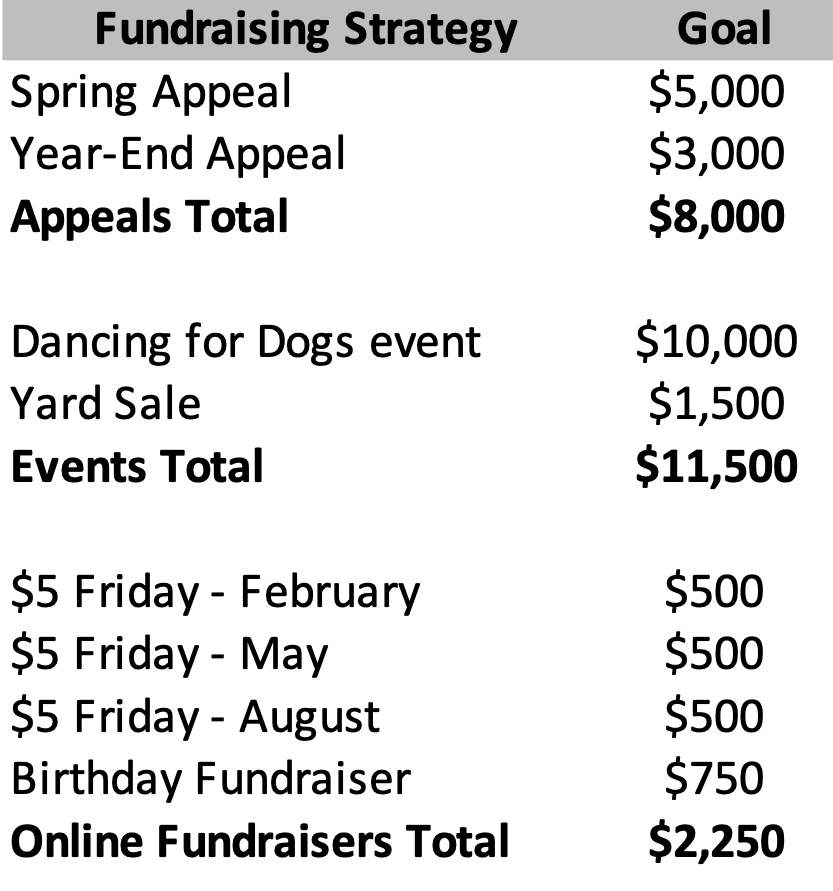
The two are tied together.
In fact, you need to plan your programs first so you know what your fundraising goal has to be.
If you just try to raise as much as you can — then figure out how to spend it — you’ll be doing things backwards.
And it’s really hard to tell donors how their donation will make a difference, because the truth is that you don’t know.
Your nonprofit’s future will look less daunting if you project your fundraising revenue while you’re planning your year, including mapping out what you plan to do in each program and calendaring all your marketing and fundraising activities.
Yes, there will still be some unknowns.
But when you have revenue projections for your fundraising plan, you’ll be able to rest a little easier knowing where the money is coming from to pay for everything.
This is an important exercise for every nonprofit.
You don’t get a ‘pass’ if you think you’re not a numbers person or if this is your nonprofit’s first budget!
I know that budgets and projections might not be the easiest thing for many people, so let me break it down and make it more manageable for you.
3 Rules for Projecting Fundraising Revenue
Before you start thinking about revenue projections, start with these three rules:
Rule #1: Separate reality from hope. Work with numbers and data, especially pieces you feel confident in.
Hope is not a good financial strategy – especially when you’re basing your program activities on the results you want to get through fundraising.
Work from a plan instead.
Rule #2: Trust yourself. Sometimes when making projections, you have to step out on a limb.
In short, there will be times when you have to guess.
But it’s an educated guess because you know more than you think you do.
You’ll guess and get it right, or close to right, because you know what your organization is capable of.
The more you monitor your projections and see how accurate they are, the better you’ll get at hitting the bullseye in the future.
Rule #3: Be conservative. Give yourself some grace by keeping your predictions on the conservative side.
I hope your event raises 20% more than it did last year, but just in case it doesn’t, make your projection closer to what you raised the year before.
Oh, and it’s totally fine to have multiple goals – one for the amount you need for the budget and one that’s a stretch goal that you don’t tell anyone about.
Conservative goals will minimize your stress and make it a nice surprise when a fundraising strategy over-performs.
Projecting revenue can feel like predicting the weather. No matter how much sun is in the forecast, a storm can always come out of nowhere.
But when you have projections that are as good as they can possibly be, you’ll be able to weather that storm.
Even if this is hard, give it a shot.
The more you work at making accurate, conservative projections, the more likely you’ll be to hit the numbers.
3 Steps to Projecting Fundraising Revenue

But, how do you do it?
First, you need to do some homework, so grab your fundraising plan.
Does it have enough detail (i.e. fundraising strategies) in it so that you have multiple types of revenue?
If not, break some things out, because the more detail the better.
For example, instead of having a single line for “Appeals” – where you lump together all revenue for the entire year for every time you send out a letter or email asking for money – add a line for each appeal you plan to send, like “Spring Appeal” and “Year-End Appeal.”
Break out events into each separate event you plan to hold.
Break out online fundraisers, like $5 Fridays, too.
So your revenue might start to look like this:

Then for each strategy/type of revenue/line on your fundraising plan, gather any data you have from previous years, along with any assumptions for how the activity might be better or different this year.
Once you have all that pulled together, you can work through the following steps to project your fundraising revenue.
Step 1: Consult past performance
The best way to predict the future is to look at the past, and that means reviewing your fundraising results from last year.
Let’s go strategy by strategy:
Individual donors: Donors who give donations between $5 and $999 are a nonprofit’s lifeblood.
-
- How many of these donors do you have?
- How many gave last year?
- What was their total giving?
- What was the average donation?
- What percent of your total fundraising came from these donors?
The answers will be helpful as you work on projecting revenue for the coming year for this strategy. 
If you have several years of data, look for trends. For instance, how much has this bucket of giving increased each year?
If individual giving has remained consistent over the past three years, you can predict that it’ll remain consistent next year.
Do you have some new strategies to add next year?
If you’ve never done a mail appeal, but are considering it, that’s a strategy that’ll bring in some revenue – if you do it correctly.
But if you’re already doing two appeals per year, it might or might not work well to add a third.
This is where fundraising becomes more art than science because now we’re talking about what your donors will respond to, and you won’t find the answer in a book.
It’s about their relationship with you and their connection to your mission.
After all, you know how much effort you’ve put into building donor relationships and what your donors will respond to. (If you don’t, you have LOTS of work to do!)
Are you adding a new fundraising campaign? Are you doing $5 Fridays on Facebook? Can you ask Board members to host a house gathering? Can you set up a table at some festivals?
Consult your fundraising plan. Look in detail at every activity.
-
- How much did it raise last year?
- Do you think you can do better this year?
- How specifically will you do better?
- What’s the number that you feel confident that the activity will bring in this year based on past results?
If you have some new strategies to implement, you can bump your individual donor prediction up a bit.
But if you plan to bump that figure up 10% or more, be prepared to explain exactly how you plan to achieve that goal (and “winging it” isn’t a correct answer).
Remember – keep it conservative so you don’t find yourself in a hole later.
Major donors: When you look at major donor revenue in your fundraising plan, you need a plan to cultivate new major donors – or that number will not move.
When estimating the total revenue from major donors, take out any large, one-time gifts like a bequest or a donor who told you, “This is a one-time donation.”
If you plan to nurture the donors you already have, you can probably count on major donor revenue to remain stable from one year to the next.
Some may drop off, but some will increase their donation. 
And you may find a few new ones!
Speaking of new major donors, if you want to increase your major donor revenue in the coming year, you definitely need a strategy and a plan.
Do you have some leads for major donors?
First, look internally. Some donors who have given $500 gifts for the past few years might be open to a conversation about increasing their gift to $1,000.
Then think about those outside your current donor family who might make their first gift a major gift.
Friends of Board members or current major donors are the best people to make referrals to others who might make big gifts.
Monthly donors: Do you have a plan to find a few more monthly givers?
If not, you can predict about 10% less in revenue because you’ll likely lose a few monthly donors along the way due to a variety of reasons like losing a job or health issues.
If you want to keep that revenue steady, you should plan activities to bring in new monthly donors.
There are lots of ways to do this, but for one, you can build in mentions of your monthly program into all your messaging, if you haven’t already.
If you’ve never done a big push for monthly donors, you may be able to increase monthly donor revenue.
Again, don’t plan for more than a 10% increase unless you can explain in detail how that’ll happen.
Events: Look at how much your signature event raised last year.
Net revenue, not gross revenue.
Think about how you can increase that revenue this year.
-
- Can you sell more tickets?
- Add a few more corporate sponsors?
- Add a silent auction component?
- Add a fund-the-need?
Events are an area where you can sometimes realize a bigger increase, even more than 10%.
But it takes work, commitment, and volunteers to pull it off.

Work with your event planning committee to create an event revenue
map that shows exactly where the revenue will come from, like the number of tickets you plan to sell, the total amount of sponsorship dollars you’re going after, and any extra fundraising or games you’re planning for the event.
If this is your first event, keep your projections modest.
Costs will eat up more revenue than you expect (they always do), especially in the first year.
Think carefully through each piece of your event revenue and how you’ll bring your plans to fruition.
Grants: Don’t include grant revenue unless you have a commitment from a foundation and know FOR SURE that the money is guaranteed.
The thing is, grants are competitive.
Just because you got a grant from a foundation this year doesn’t mean you’ll get it again next year – even if you’ve got a grant from them for several years in a row. Ask me how I know!
Also, many foundations only fund small nonprofits one time.
Sometimes, foundations only give to organizations they know well.
Many won’t even let you apply without an invitation.
So, keep this line item realistic by ONLY including grant revenue you’re 100% sure you’re going to get, such as the second installment of a two-year grant.
Now something you should do is implement a grants strategy to bring in new grant revenue, but don’t account for any of this in your fundraising revenue projections because it’s not a sure thing (until you get an award letter from a foundation and know when they money will be coming in).
The good thing is You’ll feel amazing when new grant revenue comes in that wasn’t part of your revenue projections!
Individual donors, major donors, monthly donors, events, and grants aren’t everything that you should consider in your fundraising plan.
You may have additional revenue strategies.
- Do you have corporate support that falls outside of event sponsorship and grants?
- Do you have support from the faith community?
- Do you earn revenue from memberships, paid services, or product sales?
Ask the same questions for each fundraising revenue strategy.
- How much did this bring in this year?
- Can I do a little better next year?
- How exactly will I do better?
- What exactly will I do differently?
- Do I have the time, energy, and support to do more to bring in more money?
If your nonprofit is brand new, your first year will be a baseline. Without past data to examine, you have to rely more heavily on steps 2 and 3.
Step 2: Look at Industry Trends
In Step 1, you looked inward.
In Step 2, you are going to look outward.
- How are other, similar nonprofits doing?

- Are there industry trends you can learn about that help guide you as you work through your revenue projections?
- How is the economy doing nationally and locally, and how will that impact your ability to raise funds?
- What’s the mood among donors in your community now?
- Is the nonprofit sector thriving in your community?
- Are people optimistic, talking about expanding programs and building facilities? Or is the mood more cautious?
Next, examine your peer organizations.
- Talk to your colleagues at similar organizations.
- Read their annual reports.
- Watch their social media.
- What are they sharing about their work?
- Do they seem to be growing or holding steady?
Keep an eye on industry reports like Giving USA and the Fundraising Effectiveness Project.
These two reports will show you donor giving trends and overall donor retention rates, which can be super helpful as you consider what you think YOUR donors will do.
Step 3: Consult Your Knowledge and Expertise
Now that you have looked inward and outward, it’s time to ask the expert: YOU.
That’s right, no one knows your organization better than you do.
You know what you’re capable of.
You know how many volunteers you have and the extent to which you can count on them to help with fundraising.
You know your Board, how many Board members are willing to help with fundraising, and how much capacity Board members have to give.
Adding another event to the calendar can – on paper – make your numbers work for next year. But do you have the support you need to put on another event?
As you work on projecting your fundraising revenue, what do YOU think?
Based on everything you know about your nonprofit and all your experience, what does your gut say? It’s probably right.
Is your organization capable of raising the same amount as this year or a little more? Or do you need to downshift a little bit?
It’s a myth that fundraising revenue must increase every year for your nonprofit to be successful.
Some years, there are factors beyond your control, like a tanking economy or a brewing war across the globe.
Some years will be less robust because you close out a multi-year campaign or a multi-year gift expires.
You have to apply your insider’s knowledge to predict your fundraising revenue.
And ultimately, if you’re responsible for the organization, it’s about what YOU think is doable.
The Bottom Line

Though wouldn’t that be nice?
Projecting fundraising revenue is a crucial step in the planning process.
It’s an exercise that enables you to create an accurate operating budget that’s based on data and expertise, not hope.
And it helps you make smart decisions regarding programming and staff so you can move your nonprofit forward with confidence.
By taking the time to look at the numbers and make realistic projections, you set your organization up for a successful year – one where you bring in the money you need to fund programs and change lives.
And that’s what it’s all about!







My Goal is to learn how to fundraise, and how to get it right from the Start!
Awesome! You’re definitely in the right place!